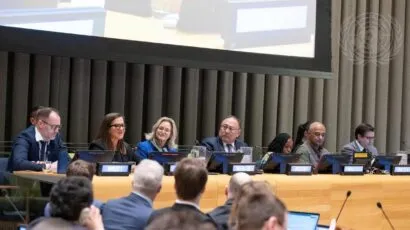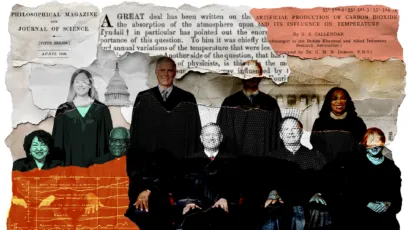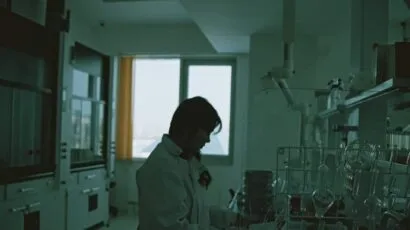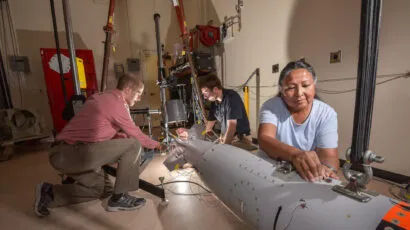Investing in pandemic prevention is essential to defend against future outbreaks
By Bridget Williams, Will MacAskill | November 2, 2022

Last September, news broke that the Rockefeller Foundation’s Pandemic Prevention Institute would no longer continue as an individual entity, but would be rolled into the foundation’s other efforts. In an interview with Science, Rick Bright, who was leading the institute before it was disbanded, noted that the Rockefeller Foundation wanted to focus on climate change, which conflicted with his desire to focus “100 percent, on pandemic prevention, preparedness, and response.”
In the same interview, Bright described the classic pattern that has come to be synonymous with pandemic prevention funding: “What we’re seeing with many foundations is there are cycles of panic and neglect: Put a lot of money and a lot of effort into the crisis of the day, and then when people believe that something’s moving on, the funding dries up.”
It’s not only philanthropy that is losing interest: Last year, The White House requested approximately $65 billion for pandemic preparedness, but so far Congress has only approved around $2 billion of funding through the PREVENT Pandemics Act. Given the health and economic costs of COVID-19 and the expected impacts of future pandemics, this is a dramatic under-investment.
After 9/11, the United States government spent many trillions of dollars on foreign interference, created the Department of Homeland Security, and declared a war on terror. In comparison, the investment to prevent future pandemics has been miniscule. In purely economic terms, much greater investment makes sense—COVID-19 cost the United States around $4 trillion. Even if a COVID-like pandemic struck just once a century, it would be worth the United States investing billions of dollars annually in global programs to prevent it. Once illness and loss of life is factored in, the investment in this cause should be considerably higher. (COVID-19 has resulted in more than a million excess deaths in the United States.)
Although there was a gap of more than 100 years between the 1918 influenza pandemic and COVID-19, it would be a mistake to still think of pandemics as a once-in-a-century event. Scientists suggest that changes in climate and land-use patterns will increase the likelihood of new viruses emerging and create more opportunities for a pandemic-capable virus to make the jump from animals to humans.
Humans are also more likely to face the threat of synthetic viruses, as advances in biology potentially make creating and editing pathogens more accessible. Such developments in biotechnology run the risk of creating future pandemics that could be much worse than COVID-19. As such, several groups have suggested that guarding against a catastrophic pandemic is necessary to help ensure a flourishing future.
It seems like a lack of awareness of these risks in government isn’t the problem. As Matt Field described in a Bulletin article earlier this year, an analysis showed there had been 167 US congressional hearings related to pandemic preparedness in the 15 years prior to the COVID-19 pandemic. So it seems that Congress was aware of pandemic risks, but in this same time period, the budget for public health emergency preparedness was reduced by a third; in 2019 there was $325 million in reduced spending compared to 2013.
This historic under-investment would have looked foolhardy five years ago. But given the damages caused by COVID-19, the ongoing under-investment looks downright reckless.
Driving the under-investment are cognitive biases and political disincentives pushing policy makers against acting now to prevent problems in the future, similar to the attitudes with regards to climate change. With pandemics, it also seems possible that under-investment is partly caused by a lack of clarity on how to effectively and rapidly spend funds. Improving health systems is an important part of mitigating pandemic risk, but this effort can only absorb so much funding. So beyond ensuring that public health systems are adequately funded, we should be looking for other opportunities to spend effectively now. Here are four areas that Congress could fund to reduce pandemic risk: vaccines for prototype pathogens, disease surveillance using metagenomic sequencing, clean indoor-air technology, and better personal protective equipment (PPE).
Developing vaccines for prototype pathogens. According to a study in The Lancet, the COVID-19 vaccine saved 14 million lives in the first year of its rollout. The speed with which the vaccines were developed defied expert predictions at the beginning of the pandemic. Much of the credit for this achievement rests with research on mRNA molecules, but is in large part due to the work on developing vaccines for other coronaviruses, particularly MERS coronavirus and SARS-CoV-1, the virus responsible for the 2002 to 2004 SARS outbreak. This meant that the design for the COVID-19 vaccines, targeting the spike protein, was essentially ready to go as soon as the details of the virus’ structure became known.
There is now a push to create vaccines for so-called prototype pathogens that act as representatives from their viral families. So in the event that a new pandemic-capable pathogen emerges, vaccine developers won’t just be starting their research and can create targeted vaccines rapidly.
If a novel virus emerges, a prototype pathogen vaccine that has cleared preclinical safety testing could be used in an emergency ring-vaccination trial. Ring vaccination involves vaccinating people who’ve been in contact with a person diagnosed with the infection to stop an outbreak in its tracks. This approach allows rapid assessment of vaccine efficacy in emergency settings and has been effective for Ebola outbreaks. Developing vaccines for prototype pathogens also doesn’t require us to go hunting for new pathogens and therefore avoids the risks of virus-identification programs.
The Coalition for Epidemic Preparedness (CEPI) has launched a campaign to create a library of vaccines for several viral families. Developing a vaccine for every viral family was one of the activities included in the White House’s plan for pandemic prevention. However, the investment needed for this has yet to happen. The White House estimated it would cost around $20 billion to create vaccines for all the major viral families. But again, Congress only approved $2 billion in funding for pandemic preparedness altogether.
Investing in metagenomic sequencing. Disease surveillance currently involves looking for specific known pathogens. While this is good for monitoring epidemiology of identified diseases, it leaves humans vulnerable to novel pathogens, which can spread quickly through a global population with little to no immunity.
A recent article in the Bulletin by Yong-Bee Lim provides a thorough overview of some of the new technologies that could dramatically improve disease surveillance. This includes metagenomic next generation sequencing, which can identify many different organisms present in a sample—including known and novel pathogens. If implemented effectively, a disease surveillance system using metagenomic sequencing approaches could act as the early warning sign that results in an outbreak being contained before it can become a pandemic. Groups like the Nucleic Acid Observatory are working on developing the tools necessary to create this early warning system.
As Lim notes, these technologies need to be improved and costs of production reduced before they can become a useful part of disease surveillance. Meaning, there should be ample investments made now to ensure there exists a disease surveillance system that’s capable of rapidly identifying novel pathogens anywhere in the world.
Implementing clean indoor air technology. Just as there is no question that drinking water needs to be treated, the air humans breathe should be clean. Some scientists have even called for a system of “ventilation certificates,” similar to food hygiene certificates. Even outside the context of pandemics, it makes sense to invest in cleaner air, with the economic costs of respiratory viruses (excluding influenza and SARS-CoV-2) to the United States estimated close to $40 billion annually.
Adequate building ventilation can reduce transmission of respiratory viruses. One study estimated that improving the ventilation in a school up to recommended standards would be as effective at reducing influenza transmission as vaccinating half the students. In settings where it’s difficult to replace indoor air with clean air from outside, systems that combine high efficiency particulate air (HEPA) filtration and ultraviolet light can effectively clean recirculated air, including eliminating SARS-CoV-2.
Other technologies can also be helpful here. One candidate is low-wavelength light, which inactivates a range of viruses and bacteria, including the viruses that cause SARS-CoV-2 and influenza and the bacteria that cause tuberculosis. Unlike higher-wavelength ultraviolet light, low-wavelength light doesn’t reach the epidermis so shouldn’t cause any damage to the skin cells. Several studies have provided evidence that low-wavelength light is safe for human skin, but given the novelty of the technology, more work is needed to confidently establish exactly how it can be used safely and effectively. In the meantime, we should be fixing building ventilation and deploying air filtration systems to make workplaces and public buildings safer.
Producing better personal protective equipment. In addition to slowing the community spread of COVID-19, masks and other types of PPE are crucial for essential workers to perform their duties in relative safety. However, the currently available PPE is fallible, uncomfortable, and interferes with communication. Fortunately, there are exciting developments in materials engineering that could make significant improvements to PPE. This includes improving the design of PPE to be more comfortable and effective, using antimicrobial materials, and developing PPE that has better temperature and moisture control to allow it to be worn more comfortably for longer durations. But while these advances are exciting, there is much more that could be done to improve PPE, and more funding would ensure research in this arena doesn’t stall.
There’s no doubt that humans will face more pandemics, and there is good reason to think that future generations will be facing even greater risks of engineered pathogens. Thankfully, there are clear steps humans can take to protect themselves from impending pandemics. These four promising areas for investment, while not inclusive of every possible effort, could be a roadmap for how funding could be allocated to effectively reduce risk. By failing to invest properly in pandemic prevention, humans are not only acting against the interests of people alive today, but also acting against the interests of future generations.
Together, we make the world safer.
The Bulletin elevates expert voices above the noise. But as an independent nonprofit organization, our operations depend on the support of readers like you. Help us continue to deliver quality journalism that holds leaders accountable. Your support of our work at any level is important. In return, we promise our coverage will be understandable, influential, vigilant, solution-oriented, and fair-minded. Together we can make a difference.
Keywords: COVID-19, Coronavirus, air filtration, pandemic, vaccines
Topics: Biosecurity, Disruptive Technologies

















What is your definition of “pandemic”? You state “Although there was a gap of more than 100 years between the 1918 influenza pandemic and COVID-19, it would be a mistake to still think of pandemics as a once-in-a-century event”. What about other influenza pandemics? What about HIV/AIDS, which surely qualifies as a pandemic, with mortality far greater than COVID-19 (and of many younger people).
However, congrats for mentioning the threat of synthetic viruses, although it’s a shame you don’t seem to explore the very strong evidence that SARS-Co-V-2 emerged from a lab, funded by the US government (eg see https://www.ncbi.nlm.nih.gov/pmc/articles/PMC9635951/).